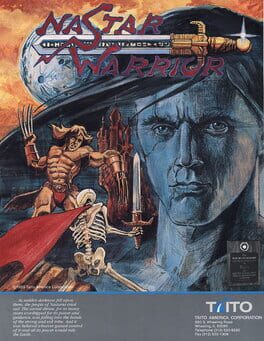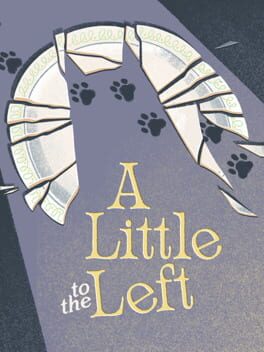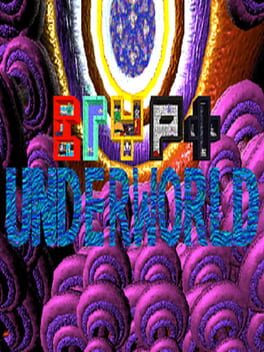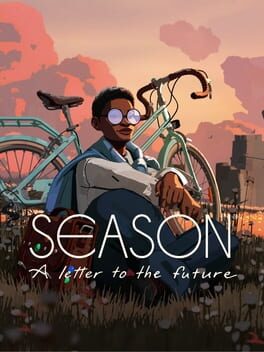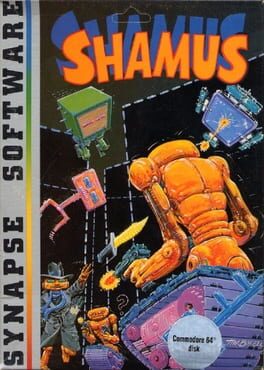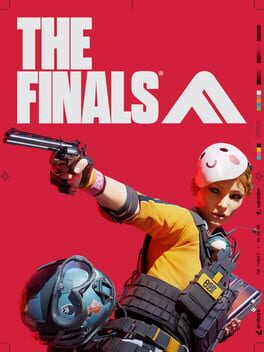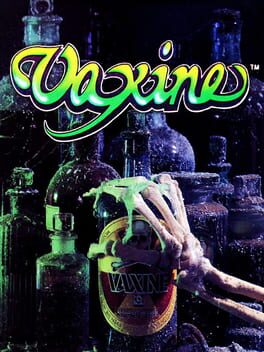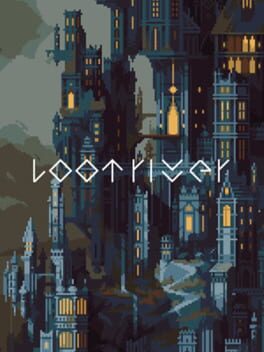vehemently
everyone please stop having opinions
TBD
i like my lovers like i like my substandard msx scrolling shooters.....
1989
not very good, but in a way that kind of rules? it feels pretty horrible and the level design is monstrous, but there's funny monsters and a suprisingly unique combat system. it has a sprawling and sometimes jazzy soundtrack despite having the aesthetics of a bad power metal album. i dunno, there is something admirable about any moment in history that can birth games that are both basically trash but also surprising and novel. like hell yeah nastar, sure, i dont give a shit about your greased-up beefcake but im glad youre going for it and you've done gone slathered the boy up
2022
Everything, everything
Everything, everything
In its right place, in its right place
In its right place, in its right place
Yesterday I woke up sucking a lemon, yesterday I woke up sucking a lemon
Yesterday I woke up sucking a lemon, yesterday I woke up sucking a lemon
Everything, everything
Everything
In its right place, in its right place
Right place
There are two colours in my head, there are two colours in my head
What, what is that you tried to say? What, what was that you tried to say?
Tried to say, tried to say, tried to say, tried to say
Everything
Everything
Everything
Everything
Everything, everything
In its right place, in its right place
In its right place, in its right place
Yesterday I woke up sucking a lemon, yesterday I woke up sucking a lemon
Yesterday I woke up sucking a lemon, yesterday I woke up sucking a lemon
Everything, everything
Everything
In its right place, in its right place
Right place
There are two colours in my head, there are two colours in my head
What, what is that you tried to say? What, what was that you tried to say?
Tried to say, tried to say, tried to say, tried to say
Everything
Everything
Everything
Everything
"what's going on? i also want to laugh"
1996
A snood (/snuːd/) is a type of traditionally female headgear designed to hold the hair in a cloth or yarn bag.[1] In the most common form, the headgear resembles a close-fitting hood worn over the back of the head. It is similar to a hairnet,[1] but snoods typically have a looser fit,[2] a much coarser mesh, and noticeably thicker yarn. A tighter-mesh band may cover the forehead or crown, then run behind the ears, and under the nape of the neck. A sack of sorts dangles from this band, covering and containing the fall of long hair gathered at the back. A snood sometimes was made of solid fabric, but more often of loosely knitted yarn or other net-like material. Historically (and in some cultures still in use today) a small bag of fine thread—netted, tatted, knitted, crocheted, or knotted (see macramé)—enclosed a bob of long hair on the back of the head or held it close to the nape.[3]
Beard snood
Another similar garment which is also referred to as a snood is used to cover facial hair such as beards and moustaches when working in environments such as food production.[4] Although it appears that "hairnet" has replaced "snood" as the common term for hair containment on the head, the term "beard snood" (essentially a "ringed scarf") is still familiar in many food production facilities.[citation needed]
Religious use
Women's snoods are often worn by married Orthodox Jewish women,[5] according to the religious requirement of hair covering (see Tzniut). Since these snoods are designed to cover the hair more than hold it,[6] they are often lined to prevent them from being see-through. Contemporary hair snoods for Jewish women come in a wide range of colors and designs.[7]
Snoods are also worn by some Christian women as a headcovering in obedience to 1 Corinthians 11:2–10.
Beard snood
Another similar garment which is also referred to as a snood is used to cover facial hair such as beards and moustaches when working in environments such as food production.[4] Although it appears that "hairnet" has replaced "snood" as the common term for hair containment on the head, the term "beard snood" (essentially a "ringed scarf") is still familiar in many food production facilities.[citation needed]
Religious use
Women's snoods are often worn by married Orthodox Jewish women,[5] according to the religious requirement of hair covering (see Tzniut). Since these snoods are designed to cover the hair more than hold it,[6] they are often lined to prevent them from being see-through. Contemporary hair snoods for Jewish women come in a wide range of colors and designs.[7]
Snoods are also worn by some Christian women as a headcovering in obedience to 1 Corinthians 11:2–10.
doom 2 is better than doom 1 because i spend less time thinking about the weirdos who treat liking doom as their entire personality
2023
when i play games like this the most prominent emotion i feel is just envy at the confidence and audacity to make just utterly deranged art without an ounce of shame detected. could never be me but god i wish it were
I’ve never understood what exactly is meant when they say that scent is the sense most intimately linked to memory. How can that be? How can one sense be the tether that ties us to memory like that? What do we meant when we say that? Do we mean that scent is the siren, the call to the shore? Maybe. The first thing you do in Season: A Letter to the Future is divide memory into senses. In attending to our senses, we ground ourselves and our experience in material sensation. But then we extrapolate, we use our senses as a sail, and go into a story.
There’s a scene in Yokohama Kaidashi Kikou where Alpha, the android, is watching the water at sundown with an older woman. It grows dark, and under the water, lights flicker on. Lamps hanging over city streets, now totally flooded. In this moment, we are made acutely aware of climate collapse that led to the world of its fiction. But to say that story, or Season, are post-apocalyptic, or apocalyptic at all, is wrong, in my view. Apocalyptic fiction is obsessed with a very specific conception of apocalypse. Apocalypse, originally, referred to revelation of any sort, but the eschatology of Christianity is known to be a little grim and scary, brimstone and all that. Apocalyptic fiction follows suit; apocalypse is a dystopic, irreversible catastrophe that does not just transform but annihilates. And it is what is left, what is unannihilated, where the meaning of these apocalypses tends to reveal itself. Apocalyptic fiction is always oriented toward the past, because in order to understand itself as apocalypse it must sanctify the past and damn the future.
Things like Season and Yokohama Kaidashi Kikou, meanwhile, envision futures transformed but by no means marred by annihilation. There are no gritty and dusty drifters or doomsday cults. Season is not post-, pre-, or mid-apocalypse, not in the sense of apocalyptic fiction. It is made very clear that this is a season, not a world being demolished, but a period of time like any other, coming to an end. This isn’t so terrifying. The war has been over for years. The Grey Hand, a sort of charitable corps, wants to help everyone get through the process, even if they are a bit paternalist. Things will be okay. This world may be gone soon, but the world will continue.
But what is at risk is memory. Your mission is simple. Document the season. Memory is fragile, but documents are durable. Memory is not the past, but an imagination of the past. A document transmutes phenomena into noumena. As Flusser says of the photograph, it turns history into something ahistorical, atemporal. Take a picture. It will last longer.
But then there’s what Suzanne Briet says: that an antelope, taken into an archive, becomes a document of antelopes. And suddenly, the feeling of violence creeps in. Memory in Season is sacred, but it can also be painful. There is only so much we can bear to remember. If I had the time, if I had the memory, if I had done the reading, maybe I could say something about clever about Heidegger or Proust, instead of relying on my shallow well of sophomoric readings, misremembered quotations, written under sleep deprivation and without editing. Even now, I want to write more than I’ve written, plumb some deeper meanings, even though I know it does not all need to be given a life longer lasting than bronze. In Season, Memory can even be found involuntarily embedded in the world, in crystals called Harpik. People lose sense of time and space, totally incapacitated by memory. Is it wrong to pluck things from this world, bury them in this book? Should some things be forgotten? War, grief, soda bottles, crass jokes, ugly romances? What is worth remembering?
For years, I've had the sensation I can't shake that as time goes on, we're more and more, as a society, unable to get our heads out of the past. Cultural memory as a pseudohistory can be intoxicating. Vaporwave and hauntological pop is always striving towards the past, always in search of a present that was never there. Fascists and reactionaries are obsessed with the past, but so are their opponents, just with different fixations. Just today, I heard an opinion from Nietzche saying that an excess of history will drain us of life. It can be intoxicating to imagine pasts, when the future, so distorted by visions of apocalypse and dystopia, seems to have disappeared entirely. I look at the art that has come out for the past decade, and I see so many ruins, overgrown and ancient. The present can only be understood as something that will, inevitably, be reduced to ash. Maybe it's because the present imagined is always a present remembered. Never a present as it is. Not was, but is.
Forgetting, just like memory, is sacred, too, in Season, though not without fear. Forgetting is powerful, but necessary. The people of Tieng Valley revere the unfathomable past. Forgetting is a quiet sacrifice. By forgetting, we revoke the past of its hold over us, free ourselves from the grip of memory. And then, there is sleep, what Season refers to as the unification of remembering and forgetting. But I think, in a sense, sleep is the abnegation of the present. The past is gone, the future is unknown, and the present is invisible. All vestiges of time, of any kind of history, disappear in the pool of sleep.
But there’s tension here. There is virtue in memory, in forgetfulness, in sleep. But how can we embody all these contradictory virtues? There’s no reason to fear olam haba, it’s good to accept the world to come, but I still can’t bear to accept forgetting. Surely, it’s better to remember, right? All of this, this “archive fever”, is a war against death, isn’t it? Isn’t that a good enough reason? But there’s never enough time, never enough memory. Things will be forgotten. There’s no question. The flood will come, and the valley will be scrubbed of everything but Harpik. I don’t know if I can bear it, but it’s going to happen anyway. The visions of a cruel apocalypse are wrong, but whenever I try to imagine the future, I’m always beset with a singular dread of everything being forgotten. Everything I care about, everything I’ve done, everything that matters to me. Only so many things can fit on the page of a scrapbook. I look at Season, and know that I should attend to my senses in the present, should be at peace with sleep, that I shouldn’t fear the future, that I should be to strive to be remembered, and be grateful to be forgotten. But I can’t hold it in my heart, can’t feel it for real. Not yet. Maybe in the next season.
There’s a scene in Yokohama Kaidashi Kikou where Alpha, the android, is watching the water at sundown with an older woman. It grows dark, and under the water, lights flicker on. Lamps hanging over city streets, now totally flooded. In this moment, we are made acutely aware of climate collapse that led to the world of its fiction. But to say that story, or Season, are post-apocalyptic, or apocalyptic at all, is wrong, in my view. Apocalyptic fiction is obsessed with a very specific conception of apocalypse. Apocalypse, originally, referred to revelation of any sort, but the eschatology of Christianity is known to be a little grim and scary, brimstone and all that. Apocalyptic fiction follows suit; apocalypse is a dystopic, irreversible catastrophe that does not just transform but annihilates. And it is what is left, what is unannihilated, where the meaning of these apocalypses tends to reveal itself. Apocalyptic fiction is always oriented toward the past, because in order to understand itself as apocalypse it must sanctify the past and damn the future.
Things like Season and Yokohama Kaidashi Kikou, meanwhile, envision futures transformed but by no means marred by annihilation. There are no gritty and dusty drifters or doomsday cults. Season is not post-, pre-, or mid-apocalypse, not in the sense of apocalyptic fiction. It is made very clear that this is a season, not a world being demolished, but a period of time like any other, coming to an end. This isn’t so terrifying. The war has been over for years. The Grey Hand, a sort of charitable corps, wants to help everyone get through the process, even if they are a bit paternalist. Things will be okay. This world may be gone soon, but the world will continue.
But what is at risk is memory. Your mission is simple. Document the season. Memory is fragile, but documents are durable. Memory is not the past, but an imagination of the past. A document transmutes phenomena into noumena. As Flusser says of the photograph, it turns history into something ahistorical, atemporal. Take a picture. It will last longer.
But then there’s what Suzanne Briet says: that an antelope, taken into an archive, becomes a document of antelopes. And suddenly, the feeling of violence creeps in. Memory in Season is sacred, but it can also be painful. There is only so much we can bear to remember. If I had the time, if I had the memory, if I had done the reading, maybe I could say something about clever about Heidegger or Proust, instead of relying on my shallow well of sophomoric readings, misremembered quotations, written under sleep deprivation and without editing. Even now, I want to write more than I’ve written, plumb some deeper meanings, even though I know it does not all need to be given a life longer lasting than bronze. In Season, Memory can even be found involuntarily embedded in the world, in crystals called Harpik. People lose sense of time and space, totally incapacitated by memory. Is it wrong to pluck things from this world, bury them in this book? Should some things be forgotten? War, grief, soda bottles, crass jokes, ugly romances? What is worth remembering?
For years, I've had the sensation I can't shake that as time goes on, we're more and more, as a society, unable to get our heads out of the past. Cultural memory as a pseudohistory can be intoxicating. Vaporwave and hauntological pop is always striving towards the past, always in search of a present that was never there. Fascists and reactionaries are obsessed with the past, but so are their opponents, just with different fixations. Just today, I heard an opinion from Nietzche saying that an excess of history will drain us of life. It can be intoxicating to imagine pasts, when the future, so distorted by visions of apocalypse and dystopia, seems to have disappeared entirely. I look at the art that has come out for the past decade, and I see so many ruins, overgrown and ancient. The present can only be understood as something that will, inevitably, be reduced to ash. Maybe it's because the present imagined is always a present remembered. Never a present as it is. Not was, but is.
Forgetting, just like memory, is sacred, too, in Season, though not without fear. Forgetting is powerful, but necessary. The people of Tieng Valley revere the unfathomable past. Forgetting is a quiet sacrifice. By forgetting, we revoke the past of its hold over us, free ourselves from the grip of memory. And then, there is sleep, what Season refers to as the unification of remembering and forgetting. But I think, in a sense, sleep is the abnegation of the present. The past is gone, the future is unknown, and the present is invisible. All vestiges of time, of any kind of history, disappear in the pool of sleep.
But there’s tension here. There is virtue in memory, in forgetfulness, in sleep. But how can we embody all these contradictory virtues? There’s no reason to fear olam haba, it’s good to accept the world to come, but I still can’t bear to accept forgetting. Surely, it’s better to remember, right? All of this, this “archive fever”, is a war against death, isn’t it? Isn’t that a good enough reason? But there’s never enough time, never enough memory. Things will be forgotten. There’s no question. The flood will come, and the valley will be scrubbed of everything but Harpik. I don’t know if I can bear it, but it’s going to happen anyway. The visions of a cruel apocalypse are wrong, but whenever I try to imagine the future, I’m always beset with a singular dread of everything being forgotten. Everything I care about, everything I’ve done, everything that matters to me. Only so many things can fit on the page of a scrapbook. I look at Season, and know that I should attend to my senses in the present, should be at peace with sleep, that I shouldn’t fear the future, that I should be to strive to be remembered, and be grateful to be forgotten. But I can’t hold it in my heart, can’t feel it for real. Not yet. Maybe in the next season.
1982
when ur jewish but there are no hanukkah themed games 😔😔😔
2023
Some neat mechanics and some novel game modes don't save this game from the fact that the servers will be dead in under 3 years, almost guaranteed. AI-generated voice lines and yet another suffocating progression and monetization scheme. No draw, no personality, no drip.
2023
There is something vaguely unsatisfying with how few risks Lies of P takes. I unquestionably enjoyed it, and it’s a good video game, but something was missing. The idea of making a full-length action RPG based on The Adventures of Pinocchio is an extremely bizarre pitch, and they really went and made the damn thing, but it sort of feels like, by the end, it really didn’t have to be a Pinnochio game. I think it’s gone forgotten that Pinocchio is a pretty strange and paternalist story. Modern retellings often leave out the murder of the cricket, the death of Lampwick, and the constant didactic morals. While Lies of P embraces a lot of the weirdness, it also ends up telling a pretty trite story, and a pretty rote Soulslike.
The folkloric premise of a living puppet is remade into another steampunk fantasy setting with plagues ravaging 19th-century cityscapes. Plenty of old friends are here, the turquoise fairy, the fox and the cat, and of course, Gepetto, the father figure. Arlecchino of commedia dell’arte also make an apperance. There might be other references but I can’t remember them or don’t know them. And that’s all good fun. The set-up is this: The puppets (robots) fueled by ergo (magic electricity) have somehow broken the Grand Covenant (Three Laws of Robotics) and attacked their masters in Krat (Paris), a city ravaged by Petrification Disease (plague). Y’know it really… ends up reminding me of Atomic Heart in a lot of ways, which isn’t a good thing. It’s a steampunk-y game aping another series very clearly with a plot about automation powered by magic science in a city gone to hell with a chatty sidekick and shephereded by a mysterious father figure. Though maybe that’s unfair; Lies of P is way, way better than Atomic Heart.
Now, to be fair, the game does take some wild swings (including a post-game tease that I cackled in delight at) and does engage in some interesting commentary on the source material. The cute irony of the plague’s symptoms is not lost on me and I apprecaite it. Some of the sidequests (like Arlecchino, or this one married gentleman, or an unfortunate soul found locked in a tower) have a flare of something more exciting. The paternalism present in the source material is subverted somewhat predictably but also sneaks in a religious metaphor, I think even a sort of sacreligious Christ metaphor; I’m reminded of Žižek’s comments on how, on the cross, Jesus had himself lost faith in God. I’m sure you could come up with an interesting perspective on the morality stuff going on here, but it never quite feels all together. At one point, a character tells you that lies are weapons humans use, and you would be wise to do the same. It’s one of the best lines in the game. But lying in Lies of P never seems to cut into anything, never reveals anything about its subject or its world.
And listen, I don’t think it’s fair to force this game to stand up against Bloodborne, or other games that is clearly pulling from. But at the same time it is begging you to. So many design choices seem to come from the fact that “well, those games had it!” Why does this game have gestures? I have no clue. But largely it pulls this off pretty well. The game feels good, the level design is precise, and I think the idea of mix-matching weapon parts pretty cool. My only major complaint is that some of the bosses feel a bit spongey, but maybe my build just sucked.
But I think the precision of design actually ends up being part of its downfall. All the builds and upgrades can be balanced just so. There’s always a shortcut when you need there to be. Every level is not only linear but choreographed; I can’t think of many points in the game where I felt like I was exploring. Instead, you are expertly led down the path from obstacle to obstacle, level to level, boss to boss. Make no mistake: this is good design, but it also lacks texture. Every room seems to have a directionality, and so the purpose of the space is a known quantity: go forward. The game needs more friction, more imbalance, more roughness to give me something to grip. Or maybe I’m full of shit.
Despite my smugness I do think Lies of P is a good game. But it needs more texture. All the mechanical friction that made its inspirations so memorable is sanded away. It contorts its source material into something edgy but without anything to slice. It’s a good game, but it feels too slick. The heart that beats under Lies of P runs like clockwork. It is mechanical, precise, reliable. But there’s not enough blood pumping through it. Maybe if they can find a rougher edge, maybe then the next Pinnochio will grow up to be a real game.
The folkloric premise of a living puppet is remade into another steampunk fantasy setting with plagues ravaging 19th-century cityscapes. Plenty of old friends are here, the turquoise fairy, the fox and the cat, and of course, Gepetto, the father figure. Arlecchino of commedia dell’arte also make an apperance. There might be other references but I can’t remember them or don’t know them. And that’s all good fun. The set-up is this: The puppets (robots) fueled by ergo (magic electricity) have somehow broken the Grand Covenant (Three Laws of Robotics) and attacked their masters in Krat (Paris), a city ravaged by Petrification Disease (plague). Y’know it really… ends up reminding me of Atomic Heart in a lot of ways, which isn’t a good thing. It’s a steampunk-y game aping another series very clearly with a plot about automation powered by magic science in a city gone to hell with a chatty sidekick and shephereded by a mysterious father figure. Though maybe that’s unfair; Lies of P is way, way better than Atomic Heart.
Now, to be fair, the game does take some wild swings (including a post-game tease that I cackled in delight at) and does engage in some interesting commentary on the source material. The cute irony of the plague’s symptoms is not lost on me and I apprecaite it. Some of the sidequests (like Arlecchino, or this one married gentleman, or an unfortunate soul found locked in a tower) have a flare of something more exciting. The paternalism present in the source material is subverted somewhat predictably but also sneaks in a religious metaphor, I think even a sort of sacreligious Christ metaphor; I’m reminded of Žižek’s comments on how, on the cross, Jesus had himself lost faith in God. I’m sure you could come up with an interesting perspective on the morality stuff going on here, but it never quite feels all together. At one point, a character tells you that lies are weapons humans use, and you would be wise to do the same. It’s one of the best lines in the game. But lying in Lies of P never seems to cut into anything, never reveals anything about its subject or its world.
And listen, I don’t think it’s fair to force this game to stand up against Bloodborne, or other games that is clearly pulling from. But at the same time it is begging you to. So many design choices seem to come from the fact that “well, those games had it!” Why does this game have gestures? I have no clue. But largely it pulls this off pretty well. The game feels good, the level design is precise, and I think the idea of mix-matching weapon parts pretty cool. My only major complaint is that some of the bosses feel a bit spongey, but maybe my build just sucked.
But I think the precision of design actually ends up being part of its downfall. All the builds and upgrades can be balanced just so. There’s always a shortcut when you need there to be. Every level is not only linear but choreographed; I can’t think of many points in the game where I felt like I was exploring. Instead, you are expertly led down the path from obstacle to obstacle, level to level, boss to boss. Make no mistake: this is good design, but it also lacks texture. Every room seems to have a directionality, and so the purpose of the space is a known quantity: go forward. The game needs more friction, more imbalance, more roughness to give me something to grip. Or maybe I’m full of shit.
Despite my smugness I do think Lies of P is a good game. But it needs more texture. All the mechanical friction that made its inspirations so memorable is sanded away. It contorts its source material into something edgy but without anything to slice. It’s a good game, but it feels too slick. The heart that beats under Lies of P runs like clockwork. It is mechanical, precise, reliable. But there’s not enough blood pumping through it. Maybe if they can find a rougher edge, maybe then the next Pinnochio will grow up to be a real game.
1990
Perhaps the biggest disparity between a badass fucking cover and utter desolation of the actual game I've ever seen
Look at that cool skeleton hand! Look at the ooze! The premise is that you've been minitiarized to kill a virus in the Presiden't bloodstream! the game? you shoot colored orbs at other colored orbs and they explode into more colored orbs while listlessly gliding through the infinite checkerboard. its orbs all the way down.
Look at that cool skeleton hand! Look at the ooze! The premise is that you've been minitiarized to kill a virus in the Presiden't bloodstream! the game? you shoot colored orbs at other colored orbs and they explode into more colored orbs while listlessly gliding through the infinite checkerboard. its orbs all the way down.
2022
smdh at everyone comparing this game to tetris. you lot never see a klotski puzzle before? sad
This review contains spoilers
Click here to read this on Medium with images.
It is six o’clock, and I am picking my father up from the airport. I’m inching through the parking lot, flanked on both sides by an unrelenting phalanx of cars. I am beset with a singular dread. “This is hell,” I say to myself. Because there’s nothing I can do other than move slowly through this corridor, hoping to find an empty space. Claustrophobia, nowhere to run, just walls of cars. As the feeling closes in on me, I check my phone. My clock is right, but the day is wrong; his flight is tomorrow. I’ve driven all the way out here essentially for nothing. This means that, for a brief moment, the only thing I can do in this parking lot is, well, be. The parking lot’s sole purpose is to house cars, and I’m not a car. This means the simple act of existing, in a parking lot, is hostile. “This is hell,” I say to myself again.
I escaped the parking lot, and driving home, I found myself acutely aware of just how uninhabitable places I moved through were. Built for cars, but not built for people. The highways, a flat vascular system without flora or fauna. The underpass, an incidental sukkah with no kindness and no nourishment. The industrial part of town, with wide, long roads and warehouses, dead grass in the gaps of concrete. There is a violence to it: the possibility of a human life is rejected. I try to imagine anyone living in these places. Anyone living a life. And I can’t.
As I played Armored Core VI: Fires of Rubicon, I kept thinking about that parking lot. How unnatural it felt to be in such a place. How impossible human life felt. How unforgiving it was to bodies.
There’s this adage in some circles (or the ones I am adjacent to) that mech fiction is, fundamentally, about bodies. I grimace when I hear this, not because there isn’t truth to it, but because I feel it’s a bit myopic and jealous. Mech fiction is about a lot more than just bodies, and to reduce a genre to some core theme is obviously absurd. But as I play Armored Core VI, I cannot stop thinking about bodies. Not because of any bodies in view. Rather, their absence haunts Rubicon.
You never see any human beings in Armored Core VI. You see sketches of them, drawn an unknowable time ago, but every voice you hear on the comms, every pilot who threatens your life, they’re disembodied and faceless. In Can Androids Pray?, two pilots have to interrogate the possibility that they’ve never had a body, that their consciousness exists solely within the mech that lies broken in the sand. A part of me wonders why no one asks this question on Rubicon. Going through this game’s world, I struggle to imagine how anyone could live here. I challenged myself, constantly, to imagine life here. But I couldn’t.
Armored Core VI is a level-based game, which is a rarity these days. Some AAA releases still hold on, like Monster Hunter, which I couldn’t help but think about. Levels increase a sense of artificiality to a space; the pretense that these are real places in a real world melts away. They cannot exist in a contiguous map, because they don’t exist in a world. In Monster Hunter, these spaces feel like safari enclosures: brimming with life, but ultimately an artificial. And in a lot of games (especially the more amateur ones) there can be these wide open spaces that call to mind a Chirico painting: great, empty piazzas, flat spaces of architectural form, punctuated with surreal substance. But on Rubicon, rather than the quaint Italian architecture, these tableaus are dominated by the industrial, the mechanical, the brutal.
Your mech stands over a massive mining pit. Machinery hangs over it like a mobile. Ayre says to you, “Even the Rubiconians have forsaken this lifeless place.” This puzzles me. What does she mean “this lifeless place”? This place is just as lifeless as anywhere on Rubicon, anywhere I’ve been. The Rubiconians want to live on Rubicon, make a life here. I’m not sure such a thing is even possible.
As I look at these battlefields, I see a sort of primordial brutalism assault me. You stomp through Xylem, the one of the closest things the entire game has to a liveable place, and it feels so wrong. These squat skyscrapers and massive intersections freckling the playspace. It feels like a massive folly city. All artifice. Then I think of Babbdi, an independent game set in the eponymous city, which sees you attempt to leave a brutalist city. It’s largely empty, and difficult to navigate without the aid of various tools. The people who live here are strange and sad. I’m filled with unease as I look up in awe at the columns of concrete and grids of rebar. Now, I think there is a charm to brutalism; it’s unpretentious and simple, as easy to contemplate as it is to ignore. But in these places, I have to ask myself why it feels so wrong to wonder through them. Why, when addressing brutalism in these ways, does it feel so horrible? Paul Virilio, in Bunker Archaeology, considers brutalism as a style of war, that brutalism has rendered the urban an ugly reflection of the bunker.
“Slowed down in his physical activity but attentive, anxious over the catastrophic probabilities of his environment, the visitor in this perilous place is beset with a singular heaviness; in fact he is already in the grips of that cadaveric rigidity from which the shelter was designed to protect him.”
If brutalism is as Virilio says, and adopts the architectural language of the bunker, and thus the reproduction of war, then brutalism is the core language of most video games. And look closely, and you can see it everywhere. These are worlds designed for violence, as Jacob Geller puts it, and it shows. Open up any number of games, and you can find it. You can see the spirit of brutalism possessing all the vertices of Quake II, see it in the industrial dystopias of Half Life 2, see it in the sprawling slaughterscapes of S.T.A.L.K.E.R. and PUBG. The architecture of these games is brutalism just as Virilio describes: the mirror image of the battlefield in the urban.
But typically, as you skulk through a dilapidated factory, you can imagine what someone could do there. You can envision someone walking through these spaces, going to work, walking home. And you see people, NPCs or enemies or corpses, around here. The city of Babbdi, despite its imposing height, does have citizens, living their little lifes, dying their little deaths. Life is possible here, abject or not. Grass poking through gaps in the sidewalk. Meanwhile, Umurangi Generation rages, joyously and passionately, against the hostility of brutalism. It’s perhaps the most scalding rejection of the naked brutalism of video games. The spires of concrete are painted with graffiti of all colors. People eat, mourn, dance. The place is undeniably alive. In spite of the very real gnawing forces of capital and empire, found manifest in the stark walls of the city, people never stop being people, they never stop living.
But when I look at the spaces of Rubicon, I cannot imagine a human even existing in these places. The spaces of Armored Core VI are often called post-apocalyptic, but that implies any society ever existed here. As I look around, I can’t see these places as even ruins. I see ladders, I see walkways, I see cars. But when I close my eyes and try to envision it, I cannot see people. As I blast my way through Grid 086, I cannot even imagine the utility of this place. What are these buildings for? What is even done here? Not just life, but labor and war, typically the last resorts of human activity that industrial capitalism permits, they both seem impossible here. No, every last vestige of the human body is invisible here. At one point, you cram your mech inside a container that’s launched across an ocean. “Cinder” Carla explains that this isn’t really built for an AC. Even the mech, an ersatz body that serves as your surrogate on this lifeless planet, is forced to bend to the hostility of this place. This planet of warehouses and parking lots.
Xylem, this floating city, is revealed to be a massive ship. The facade gives way. It unfolds like a flower and takes to the sky. Of course it’s not a city, not really. Nobody could ever really live here. How could they? What’s revealed is that Ayre, your Rubiconian ally, literally does not have a body at all. She’s a disembodied consciousness, alive in the coral. The only way to live on Rubicon is to cast off the body, imagine life as an amorphous pulse buried deep in the crust of the planet. The glimpses of organic life on Rubicon feel wrong. The trees crumple like paper when you touch them. The strange coral worms you stumble into seem like cartoons. And coral, while apparently alive, is totally amorphous and formless; it doesn’t have an anatomy. It can live here, because it doesn’t have a body. And coral flows like sand, not destructive, not creative, but a constant flux. There are no homes here, not that I can see. All I can see here is warehouses and parking lots. Stone. Rebar. Rails. Hyperbrutalism. Perhaps it’s fitting that parts of Rubicon are named anatomically and biologically: Xylem, worm robots, Ibis, “Vascular” structures. Bodies implied, but never found. After all, the only body that could live on Rubicon would be made of concrete and steel.
It is six o’clock, and I am picking my father up from the airport. I’m inching through the parking lot, flanked on both sides by an unrelenting phalanx of cars. I am beset with a singular dread. “This is hell,” I say to myself. Because there’s nothing I can do other than move slowly through this corridor, hoping to find an empty space. Claustrophobia, nowhere to run, just walls of cars. As the feeling closes in on me, I check my phone. My clock is right, but the day is wrong; his flight is tomorrow. I’ve driven all the way out here essentially for nothing. This means that, for a brief moment, the only thing I can do in this parking lot is, well, be. The parking lot’s sole purpose is to house cars, and I’m not a car. This means the simple act of existing, in a parking lot, is hostile. “This is hell,” I say to myself again.
I escaped the parking lot, and driving home, I found myself acutely aware of just how uninhabitable places I moved through were. Built for cars, but not built for people. The highways, a flat vascular system without flora or fauna. The underpass, an incidental sukkah with no kindness and no nourishment. The industrial part of town, with wide, long roads and warehouses, dead grass in the gaps of concrete. There is a violence to it: the possibility of a human life is rejected. I try to imagine anyone living in these places. Anyone living a life. And I can’t.
As I played Armored Core VI: Fires of Rubicon, I kept thinking about that parking lot. How unnatural it felt to be in such a place. How impossible human life felt. How unforgiving it was to bodies.
There’s this adage in some circles (or the ones I am adjacent to) that mech fiction is, fundamentally, about bodies. I grimace when I hear this, not because there isn’t truth to it, but because I feel it’s a bit myopic and jealous. Mech fiction is about a lot more than just bodies, and to reduce a genre to some core theme is obviously absurd. But as I play Armored Core VI, I cannot stop thinking about bodies. Not because of any bodies in view. Rather, their absence haunts Rubicon.
You never see any human beings in Armored Core VI. You see sketches of them, drawn an unknowable time ago, but every voice you hear on the comms, every pilot who threatens your life, they’re disembodied and faceless. In Can Androids Pray?, two pilots have to interrogate the possibility that they’ve never had a body, that their consciousness exists solely within the mech that lies broken in the sand. A part of me wonders why no one asks this question on Rubicon. Going through this game’s world, I struggle to imagine how anyone could live here. I challenged myself, constantly, to imagine life here. But I couldn’t.
Armored Core VI is a level-based game, which is a rarity these days. Some AAA releases still hold on, like Monster Hunter, which I couldn’t help but think about. Levels increase a sense of artificiality to a space; the pretense that these are real places in a real world melts away. They cannot exist in a contiguous map, because they don’t exist in a world. In Monster Hunter, these spaces feel like safari enclosures: brimming with life, but ultimately an artificial. And in a lot of games (especially the more amateur ones) there can be these wide open spaces that call to mind a Chirico painting: great, empty piazzas, flat spaces of architectural form, punctuated with surreal substance. But on Rubicon, rather than the quaint Italian architecture, these tableaus are dominated by the industrial, the mechanical, the brutal.
Your mech stands over a massive mining pit. Machinery hangs over it like a mobile. Ayre says to you, “Even the Rubiconians have forsaken this lifeless place.” This puzzles me. What does she mean “this lifeless place”? This place is just as lifeless as anywhere on Rubicon, anywhere I’ve been. The Rubiconians want to live on Rubicon, make a life here. I’m not sure such a thing is even possible.
As I look at these battlefields, I see a sort of primordial brutalism assault me. You stomp through Xylem, the one of the closest things the entire game has to a liveable place, and it feels so wrong. These squat skyscrapers and massive intersections freckling the playspace. It feels like a massive folly city. All artifice. Then I think of Babbdi, an independent game set in the eponymous city, which sees you attempt to leave a brutalist city. It’s largely empty, and difficult to navigate without the aid of various tools. The people who live here are strange and sad. I’m filled with unease as I look up in awe at the columns of concrete and grids of rebar. Now, I think there is a charm to brutalism; it’s unpretentious and simple, as easy to contemplate as it is to ignore. But in these places, I have to ask myself why it feels so wrong to wonder through them. Why, when addressing brutalism in these ways, does it feel so horrible? Paul Virilio, in Bunker Archaeology, considers brutalism as a style of war, that brutalism has rendered the urban an ugly reflection of the bunker.
“Slowed down in his physical activity but attentive, anxious over the catastrophic probabilities of his environment, the visitor in this perilous place is beset with a singular heaviness; in fact he is already in the grips of that cadaveric rigidity from which the shelter was designed to protect him.”
If brutalism is as Virilio says, and adopts the architectural language of the bunker, and thus the reproduction of war, then brutalism is the core language of most video games. And look closely, and you can see it everywhere. These are worlds designed for violence, as Jacob Geller puts it, and it shows. Open up any number of games, and you can find it. You can see the spirit of brutalism possessing all the vertices of Quake II, see it in the industrial dystopias of Half Life 2, see it in the sprawling slaughterscapes of S.T.A.L.K.E.R. and PUBG. The architecture of these games is brutalism just as Virilio describes: the mirror image of the battlefield in the urban.
But typically, as you skulk through a dilapidated factory, you can imagine what someone could do there. You can envision someone walking through these spaces, going to work, walking home. And you see people, NPCs or enemies or corpses, around here. The city of Babbdi, despite its imposing height, does have citizens, living their little lifes, dying their little deaths. Life is possible here, abject or not. Grass poking through gaps in the sidewalk. Meanwhile, Umurangi Generation rages, joyously and passionately, against the hostility of brutalism. It’s perhaps the most scalding rejection of the naked brutalism of video games. The spires of concrete are painted with graffiti of all colors. People eat, mourn, dance. The place is undeniably alive. In spite of the very real gnawing forces of capital and empire, found manifest in the stark walls of the city, people never stop being people, they never stop living.
But when I look at the spaces of Rubicon, I cannot imagine a human even existing in these places. The spaces of Armored Core VI are often called post-apocalyptic, but that implies any society ever existed here. As I look around, I can’t see these places as even ruins. I see ladders, I see walkways, I see cars. But when I close my eyes and try to envision it, I cannot see people. As I blast my way through Grid 086, I cannot even imagine the utility of this place. What are these buildings for? What is even done here? Not just life, but labor and war, typically the last resorts of human activity that industrial capitalism permits, they both seem impossible here. No, every last vestige of the human body is invisible here. At one point, you cram your mech inside a container that’s launched across an ocean. “Cinder” Carla explains that this isn’t really built for an AC. Even the mech, an ersatz body that serves as your surrogate on this lifeless planet, is forced to bend to the hostility of this place. This planet of warehouses and parking lots.
Xylem, this floating city, is revealed to be a massive ship. The facade gives way. It unfolds like a flower and takes to the sky. Of course it’s not a city, not really. Nobody could ever really live here. How could they? What’s revealed is that Ayre, your Rubiconian ally, literally does not have a body at all. She’s a disembodied consciousness, alive in the coral. The only way to live on Rubicon is to cast off the body, imagine life as an amorphous pulse buried deep in the crust of the planet. The glimpses of organic life on Rubicon feel wrong. The trees crumple like paper when you touch them. The strange coral worms you stumble into seem like cartoons. And coral, while apparently alive, is totally amorphous and formless; it doesn’t have an anatomy. It can live here, because it doesn’t have a body. And coral flows like sand, not destructive, not creative, but a constant flux. There are no homes here, not that I can see. All I can see here is warehouses and parking lots. Stone. Rebar. Rails. Hyperbrutalism. Perhaps it’s fitting that parts of Rubicon are named anatomically and biologically: Xylem, worm robots, Ibis, “Vascular” structures. Bodies implied, but never found. After all, the only body that could live on Rubicon would be made of concrete and steel.


